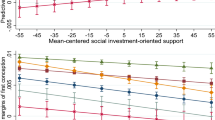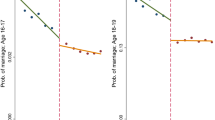Abstract
This paper is an assessment of the impact of child support enforcement and welfare policies on nonmarital teenage childbearing and motherhood. We derive four hypotheses about the effects of policies on nonmarital teenage childbearing and motherhood. We propose that teenage motherhood and school enrollment are joint decisions for teenage girls. Based on individual trajectories during ages 12–19, our analysis uses an event history model for nonmarital teenage childbearing and a dynamic model of motherhood that is jointly determined with school enrollment. We find some evidence that child support policies indirectly reduce teen motherhood by increasing the probability of school enrollment, which, in turn, reduces the probability of teen motherhood. This finding suggests that welfare offices may wish to place greater weight on outreach programs that inform more teenagers of the existence of strong child support enforcement measures. Such programs might reduce nonmarital teen motherhood further and thus reduce the need for welfare support and child support enforcement in the long run.
Similar content being viewed by others
Notes
The websites are http://www.acf.dhhs.gov/programs/cse/rpt/21t/st26.pdf, http://www.acf.dhhs.gov/programs/cse/rpt/22t/TABLE40.htm, and http://www.acf.dhhs.gov/programs/cse/rpt/annrpt23/tables/TABLE40.htm.
The website is http://aspe.hhs.gov/hsp/Waiver-Policies2000. Data were available on the approval date and implementation date for various welfare programs in 50 states over the years 1992–2000. We used the implementation date to construct our variable.
Parents’ AFDC status is available only before 1997. We distinguish those who received AFDC before 1992 but not after 1992 and those who received AFDC 1992–1996, regardless of whether receiving AFDC before 1992. We did not include the youth’s AFDC/TANF status because only very few youths ever received AFDC.
We performed a parallel analysis for young men aged 14–21 using the NLSY97 data based on the consideration that men are about 2 years older than women in sexual relationships. The results mirror what we found for teenage girls.
References
Astone, N. M., & Upchurch, D. M. (1994). Forming a family, leaving school early, and earning a GED: A racial and cohort comparison. Journal of Marriage and the Family 56, 759–771.
Blank, R. M. (2002). Evaluating welfare reform in the United States. The Journal of Economic Literature 15, 1105–1166.
Bloom, D. E., Conrad, C., & Miller, C. (1998). Child support and father’s remarriage and fertility. In I. Garfinkel, S. S. McLanahan, D. R. Meyer, & J. A. Seltzer (Eds.), Fathers under fire: The revolution in child support enforcement. (pp. 128–156). New York: Russell Sage.
Fein, D. J. (1999). Will welfare reform influence marriage and fertility? Early evidence from the ABC demonstration. Bethesda MD: Abt Assoc.
Finkel, S. F. (1995). Causal analysis with panel data. Thousand Oaks CA: Sage Publications.
Foster, E. M., & Hoffman, S. D. (2001). The young and the not quite so young: Age variation in the impact of AFDC benefits on nonmarital childbearing. In L. L. Wu, & B. Wolfe (Eds.), Out of wedlock: Causes and consequences of nonmarital fertility. (pp. 173–201). New York: Russell Sage.
Freeman, R. B., & Waldfogel, J. (1998). Does child support enforcement policy affect male labor supply?. In I. Garfinkel, S. S. McLanahan, D. R. Meyer, & J. A. Seltzer (Eds.), Fathers under fire: The revolution in child support enforcement. (pp. 94–127). New York: Russell Sage.
Garfinkel, I., Huang, C.-C., McLanahan, S., & Gaylin, D. (2003). Will child support enforcement reduce nonmarital childbearing? Journal of Population Economics 16(1), 55–70.
Garfinkel I., McLanahan S. S., Meyer D. R., & Seltzer J. A. (Eds.). (1998). Fathers under fire: The revolution in child support enforcement. New York: Russell Sage.
Gottschalk, P. (1990). AFDC participation across generations. American Economic Association Papers and Proceedings 80(2), 367–371.
Gottschalk, P. (1992). The intergenerational transmission of welfare participation: Facts and possible causes. Journal of Policy Analysis and Management, 11(2), 254–272.
Hao, L. (1997). Using a multinomial logit specification to model two interdependent processes with an empirical application. Sociological Methods and Research 26(1), 80–117.
Hao, L., Astone, N. M., & Cherlin, A. J. (2004). Adolescents’ school enrollment and employment: Effect of state welfare policies. Journal of Policy Analysis and Management 23, 697–721.
Hao, L., & Cherlin, A. J. (2004). Welfare reform and teenage pregnancy, childbirth, and school dropout. Journal of Marriage and the Family 66, 179–194.
Hardy, J. B., Astone, N. M., Brooks-Gunn, J., Shapiro, S., & Miller, T. L. (1998). Like mother, like child: Intergenerational patterns of age at first birth and associations with childhood and adolescent characteristics and adult outcomes in the second generation. Developmental Psychology 34(6), 1220–1232.
Haveman, R., & Wolfe, B. (1994). Succeeding generations: On the effects of investments in children. New York: Russell Sage.
Hsiao, C. (2003). Analysis of panel data (2nd ed.). New York: Cambridge University Press.
Huang, C.-C. (2001). The impact of child support enforcement on nonmarital and marital births: Does it differ by racial and age groups? Social Service Review 76(2), 275–301.
Huber, P. J. (1967). The behavior of maximum likelihood estimate under non-standard conditions. In Proceedings of the fifth Berkeley symposium on mathematical statistics and probability 1. (pp. 221–233). Berkeley CA: University of California Press.
Jones, A. S., Astone, N. M., Keyl, P. M., Kim, Y. J., & Alexander, C. S. (1999). Teen childbearing and educational attainment: A comparison of methods. Journal of Family and Economic Issues 20(4), 387–417.
Joyce, T., & Kaestner, R. (1996). The effect of expansions in Medicaid income eligibility on abortion. Demography 33(2), 181–192.
Joyce, T., Kaestner, R., & Kwan, F. (1998). Is Medicaid pronatalist? The effect of eligibility expansions on abortions and births. Family Planning Perspectives 30(3), 108–113.
Kaestner, R., Korenman, S., & O’Neill, J. (2003). Has welfare reform changed teenage behavior? Journal of Policy Analysis and Management 22, 225–248.
Meyer, D. R. (1998). The effect of child support on the economic status of nonresident fathers. In I. Garfinkel, S. S. McLanahan, D. R. Meyer, & J. A. Seltzer (Eds.) Fathers under fire: The revolution in child support enforcement. (pp. 67–93). New York: Russell Sage.
Moffitt, R. A. (1998). The effect of welfare on marriage and fertility. In R. A. Moffitt (Ed.) Welfare, the family and reproductive behavior. (pp. 59–97). Washington, DC: National Academies Press.
Offner, P. (2003). Teenagers and welfare reform. Washington, DC: Urban Institute.
Plotnick, R., Garfinkel, I., McLanahan, S., & Ku, I. (2005). The impact of child support enforcement policy on nonmarital childbearing. Working paper #2006–2009. Retrieved at http://www.evans.washington.edu/webtools/working_papers/Evans-Faculty-Paper.php?id = 44.
Quint, J. C., Bos, J. M., & Polit, D. F. (1997). New chance: Final report on a comprehensive program for young mothers in poverty and their children. New York: Manpower Demonstration Research Corporation.
Wu, L. L. (1996). Effects of family instability, income and income insecurity on the risk of a premarital birth. American Sociological Review 61(3), 386–406.
Wu, L. L., & Martinson, B. C. (1993). Family structure and the risk of a premarital birth. American Sociological Review 58(2), 210–232.
Yamaguchi, K. (1990). Logit and multinomial logit models for discrete-time event-history analysis: A causal analysis of interdependent discrete-state processes. Quality & Quantity 24, 323–341.
Author information
Authors and Affiliations
Corresponding author
Technical Appendix
Technical Appendix
This appendix shows the relationships between multinomial logit parameters based on a cross-classification of two endogenous variables and parameters that fit the transition of each of the two endogenous variables under Yamaguchi’s model (1990). The method converts multinomial logit parameters into parameters of interest and their standard errors.
To begin, suppose we have two dichotomous random variables A and B that take the value of either −1 or 1. Cross-classifying the two variables, we have four categories:
B | |||
|---|---|---|---|
−1 | 1 | ||
A | −1 | P 00 | P 01 |
1 | P 10 | P 11 | |
For simplicity, we have one covariate, X, and the two lagged endogenous variables with δ‘s being their parameters. A multinomial logit specification is then:
A = −1 & B = −1 is the reference category and its parameters, δ1’s, are constrained to 0.
Following Yamaguchi, let μ, φ A, φ B and φ AB represent a set of parameters that are defined as the following:
where φ A fits the log-odds of A, φ B fits the log-odds of B, and φ AB fits the A and B association. Through algebraic manipulation of equations in (2), we get:
φ At, φ Bt and φ ABt each is a function of the covariate X and the cross-lagged variables, with λ s being the corresponding parameters. We multiply each side of the equations by 4:
where \(\lambda _1^A \) is the first-order state-dependence for A t , \(\lambda _2^A \) is the lagged causal effect of B t-1 on A t , \(\lambda _3^A \) is the parameter related to the covariate. Similarly, \(\lambda _1^B \) is the lagged causal effect of A t-1 on B t , \(\lambda _2^B \) is the first-order state-dependence for B t , \(\lambda _3^B \) is the parameter related to the covariates. λ AB’s are parameters for the association between A t and B t .
Substituting Eqs. (1) and (4) into Eq. (3), we can solve for the parameters corresponding to the covariate. For example, for the parameters corresponding to At−1, we have Eq. (5) where the parameters that fit A, B, and their association AB can be expressed as linear combinations of the multinomial logit parameters:
Since the variance of a linear combination of random variables is the sum of the variance of each variable and twice the covariance among them (adjusting for the scaling and the signs), the corresponding variance for a particular parameter can be expressed as linear combinations of elements in the variance-covariance matrix of the multinomial logit estimation. For the variances of parameters corresponding to At−1, we get:
We can obtain the variance of other parameters in the same manner.
Rights and permissions
About this article
Cite this article
Hao, L., Astone, N.M. & Cherlin, A.J. Effects of child support and welfare policies on nonmarital teenage childbearing and motherhood. Popul Res Policy Rev 26, 235–257 (2007). https://doi.org/10.1007/s11113-007-9029-6
Received:
Accepted:
Published:
Issue Date:
DOI: https://doi.org/10.1007/s11113-007-9029-6




